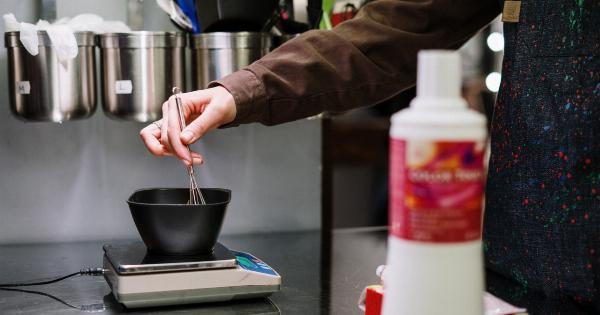Conjugation is a concept that plays a crucial role in organic and inorganic chemistry. It refers to the phenomenon where a series of alternating single and multiple bonds occur along a molecular framework.
This specific pattern of bonding is known as conjugated system or conjugation. Understanding what makes a molecule a possible conjugate is important for predicting and comprehending the behavior of various compounds in chemical reactions.
Bond Length and Connectivity
Bond length and connectivity are key factors in determining whether a molecule can exhibit conjugation. In a conjugated system, the bond lengths of the atoms involved in the alternating single and multiple bonds are usually similar.
This allows for the delocalization of electrons, resulting in enhanced stability and different electronic properties compared to non-conjugated systems. Therefore, the presence of alternating single and multiple bonds connected in a linear or cyclic arrangement enables a molecule to be a possible conjugate.
Resonance and Electron Delocalization
Resonance is another important characteristic of possible conjugates. It occurs when electrons in a molecule are not localized to a single bond but instead are delocalized over multiple bonds.
This delocalization of electrons contributes to the stability of the molecule. In conjugated systems, resonance forms can be represented by drawing different Lewis structures. These resonance forms contribute to the overall stability by distributing the electron density more evenly throughout the molecule.
The presence of resonance allows for the sharing of electrons between bonds, leading to the stabilization of the system.
Hybridization and Sp2 Orbitals
Hybridization also plays a significant role in determining whether a molecule can possess conjugation. In order for a molecule to exhibit conjugation, the atoms involved in the double bonds should have sp2 hybridization.
The sp2 hybrid orbitals have one unhybridized p orbital, which overlaps with the p orbitals of the adjacent atoms in the conjugated system. This overlapping of p orbitals allows for the formation of pi (π) bonds, which are necessary for conjugation.
The presence of sp2 hybridization in the conjugated atoms enables the delocalization of electrons and therefore contributes to the possibility of conjugation.
Pi System
The presence of a pi (π) system is essential for a molecule to be a possible conjugate. The pi (π) system is formed by the overlapping of parallel p orbitals, resulting in the formation of pi (π) bonds.
These pi (π) bonds are responsible for the delocalization of electrons in a conjugated system. The electrons in the pi (π) system are more loosely held compared to the electrons in sigma (σ) bonds, allowing for mobility and delocalization of electron density.
The pi (π) system contributes to the enhanced stability and unique properties exhibited by conjugated molecules.
Planarity and Rigidity
Planarity and rigidity are characteristics often observed in conjugated systems. In order for a molecule to exhibit conjugation, the atoms involved in the conjugated system should be coplanar.
This coplanar arrangement provides an uninterrupted pathway for the delocalization of electrons along the molecular framework. Additionally, conjugated systems are usually rigid, meaning that the molecular framework is relatively fixed and immobile.
This rigidity is necessary for the stability of the conjugated system and the preservation of the alternating single and multiple bonds.
Presence of Electron-Withdrawing or Electron-Donating Groups
The presence of electron-withdrawing or electron-donating groups in a molecule can influence its ability to undergo conjugation.
Electron-withdrawing groups have a higher electronegativity than the atoms they are attached to, causing them to withdraw electron density. These groups can disrupt the delocalization of electrons in the conjugated system and reduce the extent of conjugation.
On the other hand, electron-donating groups have a lower electronegativity and can donate electron density, promoting the delocalization of electrons and enhancing the conjugation. The presence of these groups can impact the stability and reactivity of conjugated systems.
Effect of Substituents on Conjugated Systems
The substitution of atoms or groups within a conjugated system can significantly affect its conjugation. The position and nature of the substituents can influence the extent of conjugation and alter the properties of the molecule.
Substituents that have electron-donating effects can increase the extent of conjugation by providing additional electron density. Conversely, substituents with electron-withdrawing effects can decrease conjugation. The presence of substituents can influence the overall reactivity and stability of conjugated systems, making them important considerations in studying conjugation.
Size and Extent of the Conjugated System
The size and extent of the conjugated system also play a role in determining whether a molecule is a possible conjugate. Larger conjugated systems tend to exhibit stronger conjugation and enhanced stability.
As the number of alternating single and multiple bonds increases within the conjugated system, the delocalization of electrons becomes more extensive. This leads to a greater distribution of electron density and increased stability. The size and extent of the conjugated system have a direct impact on the properties and behavior of conjugated molecules in chemical reactions.
Spectral Analysis
Spectral analysis techniques, such as ultraviolet-visible (UV-Vis) spectroscopy, can be used to determine the presence of conjugation in a molecule.
Conjugated systems often exhibit unique electronic transitions, resulting in characteristic absorption wavelengths in the UV-Vis region. By analyzing the absorption spectrum of a compound, it is possible to identify the presence of conjugation based on the observed absorption bands.
Spectral analysis provides valuable information about the conjugation present in a molecule and allows for the characterization of conjugated systems.
Applications and Significance
Understanding what makes a molecule a possible conjugate is of great significance in various areas of chemistry. Conjugation is a fundamental concept in organic chemistry and is essential for predicting the behavior of molecules in chemical reactions.
It affects the reactivity, stability, and electronic properties of compounds. The unique properties exhibited by conjugated systems find applications in a range of fields, including materials science, pharmaceuticals, and electronics.
Conjugated polymers, for example, are used in organic electronics, while conjugated systems in pharmaceutical molecules can influence their biological activities. Studying conjugation allows scientists to design and manipulate molecules with desired properties for specific applications.
Conclusion
In conclusion, several factors contribute to making a molecule a possible conjugate.
Bond length and connectivity, resonance, hybridization, the presence of a pi (π) system, planarity, and rigidity all play crucial roles in enabling a molecule to exhibit conjugation. The presence of electron-withdrawing or electron-donating groups and the effects of substituents within the conjugated system also influence conjugation.
Furthermore, the size and extent of the conjugated system impact the stability and properties of conjugated molecules. Understanding these factors and their impact on conjugation is essential for comprehending the behavior of compounds in chemical reactions and harnessing their unique properties for various applications.






























